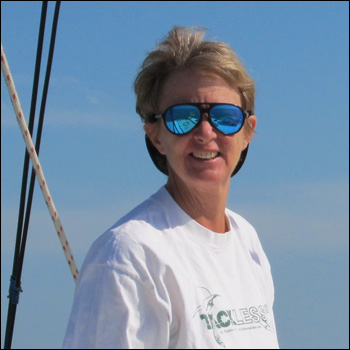When I cast out my lines of communication to the Admirals I hoped would consult with me on this column, the first question I asked them was what the cruising life was for them and what was key for getting into IT. Ironically their answers had a great deal to with home and community, concepts usually associated with living on land.
“For me,” observes Kathy Parsons of Hale Kai, a Downeast 38 cutter, “IT is feeling that my boat is truly home and that my community is a fluid one that consists of all the people that cruising has allowed me to meet – both other cruisers and people I’ve met in the countries I’ve visited.” “Friendships — with folks who so often are kindred spirits — are made quickly and solidified by shared adversity and fun,” says Mary Verlaque of I Wanda. “Nobody asks what you did in your ‘other life’, and it is simply unimportant. You are accepted (usually) by your acts and your seamanship.” And when you part ways, Folksinger Eileen Quinn reminds, “You learn to trust that the winds will cause your paths to cross again.”
Making the boat you cruise on into YOUR home is a common observation. As Mary Heckrotte of Camryka, a Westerly 36, succinctly observes, IT is the comfort of “cooking in my same old pots, sleeping in my same old bed, then looking out my porthole to see a whole different country.” Boat as home may come most naturally when a couple buys a boat together, but “too often,” writes Debbie Leisure from her 29’ Island Packet Illusions, “women move on board a boat that is HIS boat. They have little say in anything except the galley. For a woman to make that boat her home, she must become emotionally attached to it, as she probably was to her home on land.” Lisa Schofield of Lady Galadriel, who has now traveled from San Francisco to the Chesapeake on what was originally her husband’s Crealock 37, seconds that. “In my observations of other cruisers, it’s been clear that those who don’t have IT aren’t happy aboard, and many times that has to do simply with not having brought along things that give them pleasure.”
Beyond building a physical connection to the boat, the Admirals say, getting into IT extends to being party to all the decision-making of the cruise. In a crew of two, especially when husband and wife, there is no place for Bligh-like tyranny by “The Captain”, but equally there is no room for a passive passenger. It is in the best interest of life aboard that each person develops expertise in particular areas, yet each should have a working understanding of the other’s, as well On Tackless II, we have “board meetings” – usually over morning coffee or after the lights are out on the dinner dishes – during which we each report on our own “departments”, and seek the other’s input. We always consider together any upcoming plans and projects, destinations, and weather forecasts until we come to a common decision. This way we share in the responsibility.
The object of all this is achieving a self-determined lifestyle. “In cruising,” says Kathy Parsons, “you move so far outside the box of expectations, that the weight of “shoulds” largely disappears and you live your life the way you want.
”From what my Admirals say, women seeking IT will do well to cultivate in themselves such personality traits as flexibility and adaptability, an independent nature, a satisfaction at living hand-in-hand with nature, a capacity to make do with somewhat less than most of what passes for necessary in our consumption-crazy world, and a willingness to step up to the unknown. My friend Kathy Blanding of Sunflower carries the following saying in her billfold. “Live in wonder; be willing not to know.” I don’t know where that comes from, but it seems fundamental to the life of travel that cruising is. “And if you don’t travel with the boat,” points out Eileen Quinn “then it’s just living aboard!” However, she wisely adds that IT doesn’t come all at once. “The first year or two, cruising is mostly about getting to know your boat, yourself and your partner underway. There’s little spare time; every experience is new and the learning curve is steep. I promised my husband that I wouldn’t pass judgment on the lifestyle until we’d been at it a good six months.” It must have worked. Eileen and her husband have been cruising together aboard Little Giddings, a Bayfield 36, for twelve years.
This article was published in the September 2006 issue of Latitudes and Attitudes.
